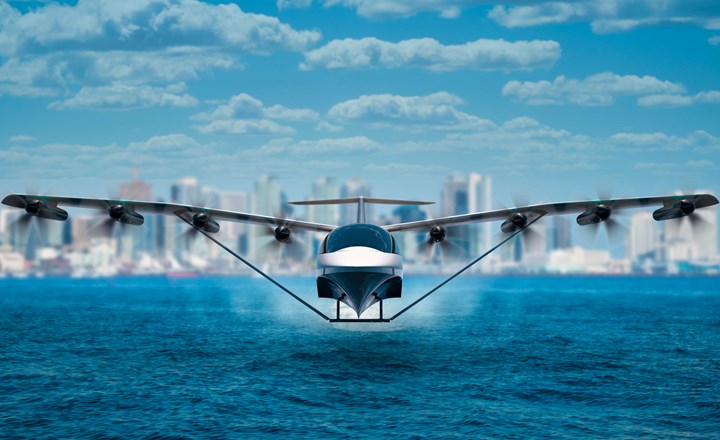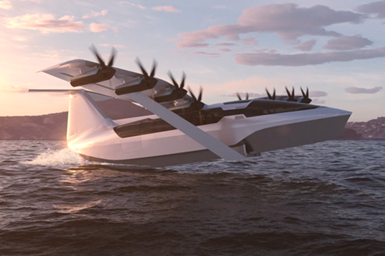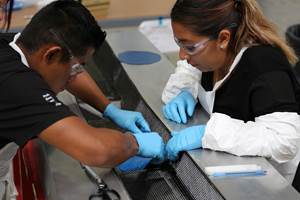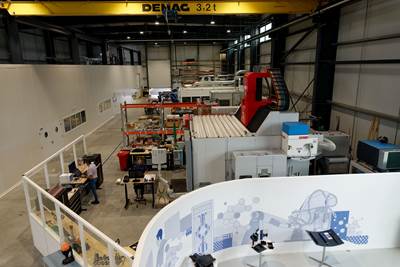Regent appoints composites builder for seaglider demonstrator
The seaglider technology demonstrator will be able to float, foil or fly along coastal routes with the help of its composite superstructure developed by Moore Brothers Company.
Share
Read Next

Regent’s seaglider vehicle demonstrator. Photo Credit, all images: Regent
Regent (Boston, Mass., U.S.) has announced that it will be building its composites-intensive seaglider technology demonstrator in collaboration with the Moore Brothers Co. (Bristol, R.I., U.S.), a composite manufacturing, research and development firm. Specifically, the Moore Brothers will be the main partner in creating the necessary components for the prototype’s 65-foot carbon fiber composite wing and hull. Regent, a venture-backed aerospace company, develops and manufactures all-electric, passenger-carrying, wing-in-ground-effect vehicles to service coastal routes. The company plans to test its technology demonstrator in the coming months ahead of the vehicle entering commercial service by 2025.
“Regent’s seaglider technology demonstrator could not come together without the expertise of Moore Brothers. They are not built in isolation, but built on the backs of strong partnerships. As we continue to grow and move towards our 2025 commercial service goal, we look forward to partnering with even more incredible firms. We couldn’t image a better partner to kick off our technology demonstrator composite work than Moore Brothers,” says Billy Thalheimer, CEO of Regent. “Our technology demonstrator is built to fully perform end-to-end capabilities of float, foil and fly. We are excited to announce more details of the technology demonstrator vehicle in the coming months.”
The Moore Brothers team brings extensive composite structure manufacturing experience in both the marine and aerospace industries. The company is said to specialize in using cutting-edge materials and innovative construction techniques to create strong, lightweight and high-performance components. Regarding the seaglider demonstrator, the company can confirm that the entire vehicle superstructure is autoclave-cured prepreg with a mix of Nomex and foam core materials. The combination of processes and material systems for the passenger-carrying vehicle version is still yet to be determined.
“Moore Brothers has thoroughly enjoyed working with Regent in the development of their technology demonstrator seaglider,” notes Oliver Moore, director at Moore Brothers. “Our engineering and production processes pair seamlessly with the Regent approach, as we both believe quality, safety and on-time delivery are key to success. We look forward to continuing to collaborate to bring more seagliders to market in the coming years.”

The seaglider can either float, foil or fly.
The Regent seaglider is an all-electric flying vessel that is reported to combine the speed, comfort and navigation systems of an aircraft with the convenience, maneuverability and affordability of a boat. Regulated and certified by maritime authorities, the seaglider will transport commercial passengers and critical cargo up to 180 miles at nearly 180 miles per hour with existing battery technology.
Leveraging existing dock infrastructure, Regent’s commercial seaglider will float, foil or fly. From the dock and while in the no-wake zone, the vehicle will float on its hull. Upon reaching 20 miles per hour, it will rise up on its retractable hydrofoil. By the time it reaches open water, the vehicle will smoothly transition onto its wing, retracts the foil and accelerates to a comfortable 180-mile-per-hour cruise speed, all while staying within a wingspan of the water’s surface. Flight safety at these altitudes is achieved using a multiple-redundant, state-of-the-art navigation and control system, Regent says. Similar to a hovercraft, seagliders fly on a dynamic air cushion created by the pressurized air between the wings and the water. The aerodynamic advantage of this so-called “ground effect,” includes significant operational efficiencies, increased payload capability and greater range.
Related Content
Composites manufacturing for general aviation aircraft
General aviation, certified and experimental, has increasingly embraced composites over the decades, a path further driven by leveraged innovation in materials and processes and the evolving AAM market.
Read MoreRevisiting the OceanGate Titan disaster
A year has passed since the tragic loss of the Titan submersible that claimed the lives of five people. What lessons have been learned from the disaster?
Read MoreBladder-assisted compression molding derivative produces complex, autoclave-quality automotive parts
HP Composites’ AirPower technology enables high-rate CFRP roof production with 50% energy savings for the Maserati MC20.
Read MoreCarbon fiber, bionic design achieve peak performance in race-ready production vehicle
Porsche worked with Action Composites to design and manufacture an innovative carbon fiber safety cage option to lightweight one of its series race vehicles, built in a one-shot compression molding process.
Read MoreRead Next
Plant tour: Daher Shap’in TechCenter and composites production plant, Saint-Aignan-de-Grandlieu, France
Co-located R&D and production advance OOA thermosets, thermoplastics, welding, recycling and digital technologies for faster processing and certification of lighter, more sustainable composites.
Read MoreAll-recycled, needle-punched nonwoven CFRP slashes carbon footprint of Formula 2 seat
Dallara and Tenowo collaborate to produce a race-ready Formula 2 seat using recycled carbon fiber, reducing CO2 emissions by 97.5% compared to virgin materials.
Read MoreAssembling the Multifunctional Fuselage Demonstrator: The final welds
Building the all-thermoplastic composite fuselage demonstrator comes to an end with continuous ultrasonic welding of the RH longitudinal fuselage joint and resistance welding for coupling of the fuselage frames across the upper and lower halves.
Read More


























